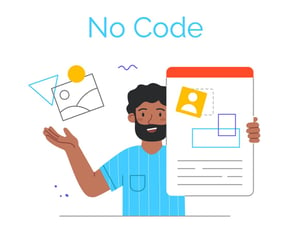In the mid-90s, there was a sudden buzz around no-code platform. Then, with the introduction of “What You See Is What You Get” or WYSIWYG editors in 1995, no-code platforms saw more demand.
Further, we saw many new no-code giants emerge like Mailchimp, WordPress, and Shopify. However, the introduction of low-code platforms later in the 2000s paved the way for an alternate development solution.
However, it was 2016 Forrester Group’s report that popularized the name of Low Code Development Platforms or LCDP. The modern-day web 2.0 community has embraced the low-code or no-code development platforms, and many believe it is a reliable option.
Low-code and no-code platforms are a double edge sword. On the one hand, non-technical employees (also called business users or citizen developers) can build applications with minimal coding knowledge. On the other hand, because of its ease of use, there could be security issues if unregulated by an IT department.
We will discuss significant security concerns for low code and no-code development platforms with practical solutions. Let’s start with what is a low-code or no-code platform and the difference between both approaches.
What are Low-code and No-code development?
Conventional software development had two approaches. You use ready-to-use software built for a general-purpose or build one from scratch. With the introduction of low code and no-code development, everything has changed. Now you can build software through a few lines of code.
Low code or no-code development is an approach to designing and developing applications through graphical tools and functions. It reduces the need for extensive coding and boosts development speeds. The best aspect of low-code development is quick startup time. In addition, a graphical interface paired with drag and drop functionality allows speedier development.
Any person without prior coding knowledge can create software using the low code development approach.

Some of the critical features of a low code development platform are,
- Visual interface: It is a graphical interface with unique tools and ready-to-use components. The complex code you may need to build such models, and features are pre-built. So, you get reusable components to create software quickly.
- Out-of-the-box functions: These are the functions that come out of the box with the low code platform reducing the need for building one from scratch. These can be software modules or even data management features.
- Drag and drop tools: Such tools enable you to quickly build software without creating modules, components, and codes.
- Reusable components: Reusability makes low code platforms one of the best alternatives to the traditional software development approach.
- Security and monitoring: A low code platform provides excellent monitoring and logging features that enable higher security.
 No-code development is similar to the low code approach in many ways but with some differences. A no-code platform adds a layer of abstraction to the code. So, you get simple drag and drop solutions rather than writing codes for each software component.
No-code development is similar to the low code approach in many ways but with some differences. A no-code platform adds a layer of abstraction to the code. So, you get simple drag and drop solutions rather than writing codes for each software component.
A no-code platform may have underlying programming languages delivering the functionality of HTML5, CSS, and JavaScript. However, you don’t need to know these languages to use the low-code platform. Nevertheless, there is no denying that low code or no-code is an excellent alternative to the conventional development approach.
Though there are many security concerns for low-code and no-code development, we need to understand the difference between them to understand these concerns.
Difference Between Low-code and No-code Development Platforms
Low code and no-code development platforms provide visual interfaces to make mobile and web app development easier. However, they differ in the core concept. Low code is an approach where minimal coding is used. So, it does not eliminate the coding aspect.
At the same time, no-code platforms have drag and drop visual elements that do not require coding. This is why low code platforms are considered ideal for improvements in developers’ productivity. At the same time, no-code platforms are for business users who have no coding knowledge.
However, there are many other differences that you need to understand.
System’s openness
An open system will allow users to change its structure or architecture. In contrast, a closed system does not allow the users to make changes. This is where both low code and no-code platforms differ.
Low code platforms allow developers to add or change the code to create software solutions and, therefore, open systems. At the same time, no-code platforms follow a closed system where there are no coding changes allowed.
Both open and closed systems have their drawbacks. While an open system has an advantage of testing and code changes, it also delays the process of deployment. Further, with an open system, there are no rollbacks; an upgrade changes the software behavior, which needs extensive testing.
On the other hand, a closed system provides a single version approach. It means that you will have a version of the app that will not drastically change the system. So, there is no need for extensive testing or the addition of custom code.
However, when you consider different security concerns of low code and no-code development, an open system is better. A new version may break the application, but the need for testing ensures that any anomaly or vulnerability gets detected. This is further rectified through the addition of custom code.
On the other hand, a closed system will have such security issues inherent in code that can’t be changed or rectified. So another key difference is scalability.
Scalability
Due to the system's openness, a low code platform has better scalability. On the other hand, a low code platform requires some code and allows you to develop a wide array of software solutions. But, a no-code platform does not allow customizations limiting the use cases.
So, you can’t scale a no-code application, while with a low-code platform, you can customize the software for better scalability. Further, with higher code customizations, low code platforms also enable developers to minimize failures during application scale.
Now that we know what some of the critical differences between low-code and no-code development platforms are, let’s look at some security concerns.
Security concerns for low-code and no-code development
Website security is a vital aspect of every business. So, it can’t be a trade-off for enhanced development capabilities. As we see rapid adoption of low code or no-code platforms, security becomes a vital factor of consideration.
So, here are some of the top security concerns for low-code and no-code development based on the Open Web Application Security Project (OWASP).
Open accessA low code platform allows developers to use their credentials as service identity. Their application does not have individual identities and traces back to the underlying credentials. So, if a user accesses your application, they gain access to credentials.
It is a significant security concern for low-code and no-code development platforms. This is where you need to customize the code and create a data access restriction. However, there are many limitations to this approach also. As you are allowed minimal coding in the low-code platform, there is not much that you can do.
Fortunately, many certification authorities provide a code-signing certificate for such security concerns. A code-signing certificate allows you to ensure that your application code remains intact and that users with specific security keys can only access it. In addition, adding a timestamp and hashing of the code will enhance security for applications.
Vulnerable migrationBusinesses often migrate their applications and resources for different reasons. It can be cost, flexibility, latency, or the need for database resilience. However, you don’t have enough security measures to prevent data leakages during such migrations with low code or no-code platforms.
It becomes problematic if you use a low-code platform for your application scaling. So, you integrate third-party services for specific functions. Execution of functions needs data access and migration, exposing your critical resources to hackers.
Here are some tips to avoid such a scenario,
- Use a strict data access policy.
- Enable multi-factor authentication for third party service users
- Have data recovery measures in place
- Leverage data encryptions to ensure that exposed information stays anonymous.
One of the most common security concerns for low-code and no-code development is authentication. The data access to your core services is through an API or HTTP protocol. Now, when it comes to security best practices, you need HTTPS.
The reason behind an HTTP protocol is low code or no-code platform. Developers of low code platforms keep the web app lightweight through minimal coding, which often leads to such security trade-offs.
So, what’s the solution?
The solution lies in encrypting your core services or the communication channel. For example, you can use SSL certificates to secure your communication with the low code platforms. Your web application built on the low code development platform will connect with the server through an HTTPS protocol. So, the data leakage and man-in-the-middle attacks can be stopped.
SSL certificates employ cryptographic algorithms to encrypt data traversing between two endpoints. Here, these endpoints are low code platforms and your server.
Dependency injectionsLow code or no code apps are not scalable inherently. So, if you want to use low code applications to serve vital business’s needs, you have to rely on the market ecosystem of connectors, components, and ready-to-use services. In addition, due to this dependency on external services, there are low-code security concerns.
Low-code platforms allow users to use external components and sources that can have malicious injections. It can expose your application to hackers, and they can manipulate the underlying source code. The best solution will be to use a web application firewall that helps secure your server from HTTP traffic.
Configurational issuesLow code or no-code platforms have pre-built features beyond the standard development tools. For example, some low code platforms allow users to create self-service portals that will enable unauthenticated users to use applications.
Now, unauthorized users get complete control if these applications are not configured for controlled data access and not defined security policies. So, hackers can tap into your app credentials and underlying source code.
The best way to ensure that there are no configurational issues for your application is to test them extensively for different scenarios. It can help you understand unauthorized access issues and discover new vulnerabilities.
Conclusion
When it comes to app development productivity and user-friendly processes, low-code and no-code development platform are best. However, there are some caveats to the use of such platforms. The security concerns for low code and no-code development platforms need reliable solutions.
From restrictive data access to SSL certifications and code-signing certificates, you can use several different measures to improve the security of low code or no-code apps. So, secure your low code apps now.
Further reading:





Comment